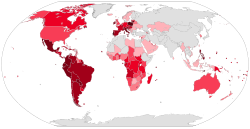| Part of a series on the |
| Catholic Church by country |
|---|
 |
| |

The Catholic Church in Rwanda is part of the worldwide Catholic Church.
Contents
There are just over five million Catholics in Rwanda - about half of the total population. The country is divided into nine dioceses including one archdiocese. The Rwandan government reported in 2012 that 43% of the Rwanda's population is Catholic. [1]
In 2020, there were 939 priest and 2219 nuns serving across 205 parishes. [2]